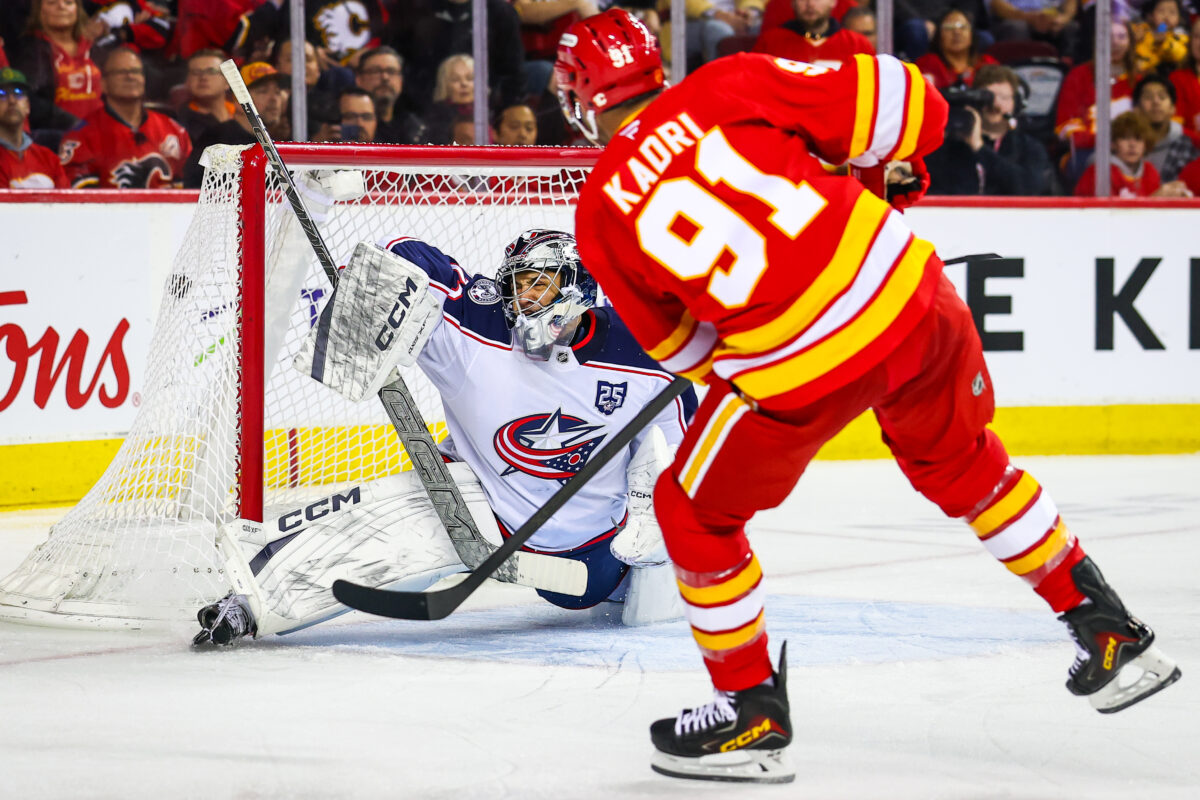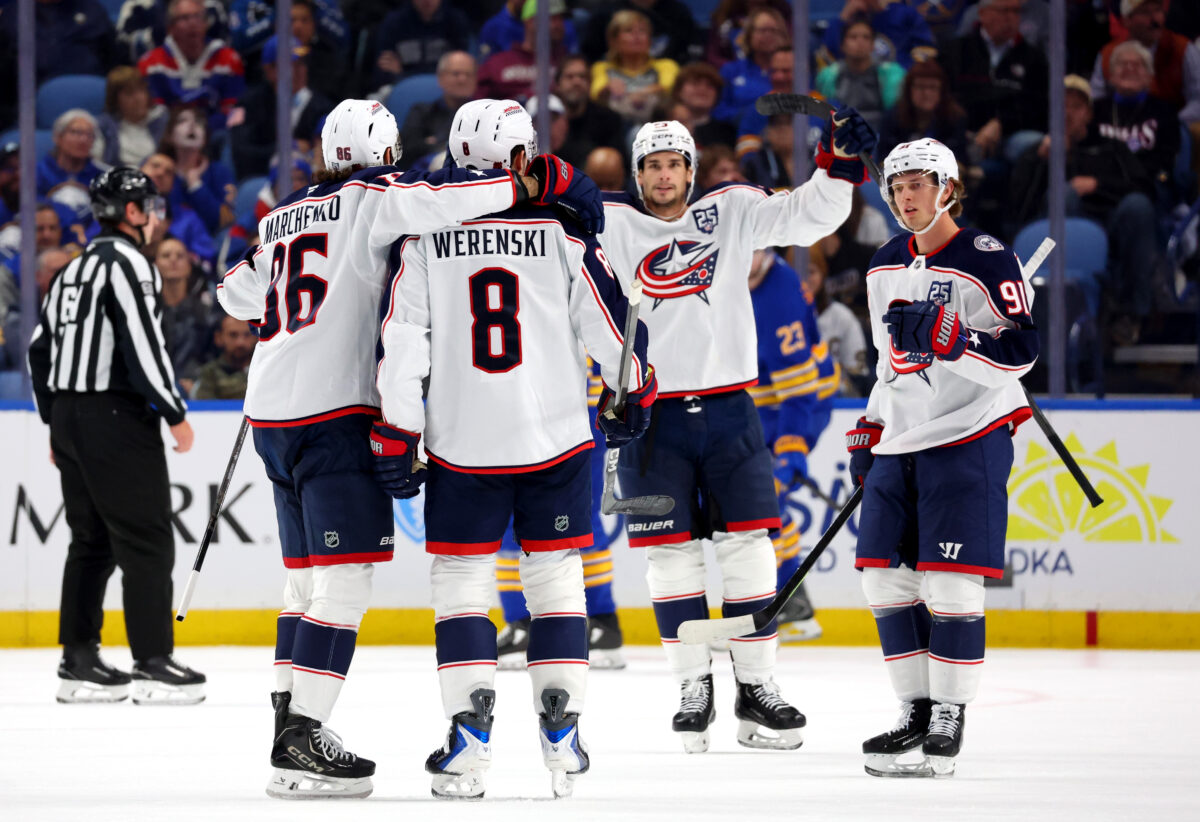The Columbus Blue Jackets were under two minutes away from improving to 8-4-0 on the season and a sweep of back-to-back games against the St. Louis Blues and New York Islanders. But life comes at you fast.
The Islanders scored twice in under 30 seconds to stun the Blue Jackets. That lull carried over to Wednesday night’s game against the Calgary Flames.
The Blue Jackets allowed two goals in under two minutes to start the game. They were never able to recover after that thanks to a career night from Flames’ goaltender Dustin Wolf.
With their 5-1 loss, the Blue Jackets are 7-6-0 heading into a compacted part of their schedule. They play against the Vancouver Canucks on Saturday night. Then the games come fast and furious.
Starting Monday night in Edmonton, the Blue Jackets will play six games in nine nights which includes two sets of three games in four nights. It’s fair to say the rest of November is an important part of their schedule.
With that in mind, let’s talk recent trends. While there are certainly plenty of things to like about the Blue Jackets so far in 2025-26, there’s plenty of room for improvement too.
In particular, there are four trends that have caught my eye that must improve soon if the Blue Jackets want to start consistently winning more. At 7-6-0 going into Saturday night’s game, it shows the good has been good enough to offset some of the bad. But riding this roller coaster will eventually catch up if they don’t take action now.
“Fire-Wagon” Hockey
Blue Jackets’ hockey to start 2025-26 has been nothing if not at least entertaining to watch at both ends of the ice. The team finds themselves in a unique position when it comes to one particular stat.
The Blue Jackets are second in the NHL at shots on goal per game firing 32.8 shots per contest. At the same time, they allow the most shots against per game at 33.4. That’s almost two shots more per game than the next team on the list. The San Jose Sharks allow 31.7 per game.

Where this particularly sticks out is in the third period. The Blue Jackets have allowed the most shots against in the third period of any team in the NHL. Remember how the game against the Blues ended?
Certainly we have to consider game situation when looking at shots. But when the end result is allowing the most shots in the third period of any team, that has to change.
While both goaltenders Jet Greaves and Elvis Merzlikins have played well collectively to start the season, that will start to catch up to both of them should this trend continue. The Blue Jackets have to start playing tighter and locking things down in their own end of the ice.
This brand of “fire-wagon” hockey can’t be sustained over the long run. Whether it’s more of a willingness to block shots or get sticks in the lane, the Blue Jackets’ defense has to get better here. That’s way too many shots allowed on a consistent basis.
Not-So-Special Teams
Teams are constantly looking for answers on their power play and penalty kill. The Blue Jackets appear to still be in search of those elusive answers on both sides. The numbers bear that out.
Coming into Saturday’s game against the Canucks, the Blue Jackets power play is 5 for 31 to start the season for 16.1%. That’s 25th in the NHL.
On the flip side, the Blue Jackets’ penalty kill has allowed 12 goals against in 38 chances for 68.4%. That’s 30th in the NHL with only the Canucks and Ottawa Senators being worse.
Take a wild guess what both the Blue Jackets and Canucks will try to emphasize on Saturday night?
It’s one thing to have special teams struggle in spurts due to the ups and downs of a long season. But it’s another altogether to have both units be among the worst in the NHL over a longer stretch.
This trend must improve soon especially given the condensed schedule. The Blue Jackets have to start using the power play to their advantage.
There is no question they have the talent to score. The mini-trend I am watching is the deployment of units. We’ll see if Sean Monahan can play Saturday night as he practiced with the team Friday. Should he not be able to play, that opens up some new possibilities as to how this unit could look.
My two cents? Put your skill on that first unit and let them go to work. Ideally, I’d like to see Werenski, Kirill Marchenko, Kent Johnson and Adam Fantilli on that top unit joined by a net-front presence. So long as they are direct and have a shot mentality, they’re too good skill wise not to eventually start scoring.

At this point, why not try it? The average power play in today’s NHL is over 21%. The Blue Jackets need a spark. It could mean points in the standings with an extra goal here or there in games.
As for the penalty kill, the Blue Jackets do a good job of not taking many penalties. They’ve been shorthanded 38 times which is fifth fewest in the NHL. But 12 goals against? That’s unacceptable.
Teams have been able to not only get setup in the offensive zone, they’ve been able to get ample zone time out of it. Whether it’s doing a better job preventing the zone entry or being more aggressive against teams when they’re set, the Blue Jackets have multiple areas they must improve on to have that percentage trend upward.
One stat some look at when it comes to special teams is combined PP and PK percentage. A 20% PP and an 80% PK is 100. That is middle of the road on both units.
The Blue Jackets combined number is 84.5 which is the lowest in the NHL. This can’t continue if the Blue Jackets hope to start consistently winning more.
Home Cooking
Nationwide Arena gave teams fits in 2024-25. To start off 2025-26, that hasn’t carried over. At least not yet anyway.
The Blue Jackets are 3-3-0 at home. They’ll play there again next on Thursday when Connor McDavid and the Edmonton Oilers come to town.
The .500 home record illustrates the issues we’ve talked about. The Blue Jackets are 1 for 17 on the power play. Only the Calgary Flames and their 1 for 25 is worse.
The penalty kill has allowed five goals in 15 chances for a 66.7% conversion rate. That’s 29th in the NHL.
The saving grace for the Blue Jackets to allow them to be above .500 despite these poor numbers is two-fold. Their goaltending and their 5-on-5 numbers have been good.
The Blue Jackets have a .906 team save percentage which is fifth-best in the NHL. They’ve also allowed just 24 5-on-5 goals against. That’s tied for sixth-fewest in the NHL.
There are things to build on. But the Blue Jackets have to start making it hard on their opponents at home. Take advantage of the last change. Produce on special teams. Start there and build up.
The Second Line
Assuming Monahan’s health, the top line is among the best in the NHL. Marchenko is outscoring the opposition 11-1 at 5-on-5 when he’s on the ice. He deserves much more attention than he’s getting about his impact.
The third late of late has been noticeable. Cole Sillinger, Charlie Coyle and Mathieu Olivier have stepped up. Each member of that line were named stars of the game against the Toronto Maple Leafs.
But it’s that second line that has my attention. In Vancouver, it could look quite different depending on health and realignment.
The second line has been the one line that hasn’t been able to find consistency yet in 2025-26. It’s a bit of a weird dynamic taking place that required a little further digging.
Boone Jenner has 2-6-8 in 13 games. Fantilli has 2-4-6 in 13 games. Johnson was moved off that line. Miles Wood joined Jenner and Fantilli in New York and was rewarded with a goal.
You May Also Like
- 4 Blue Jackets’ Trends That Must Improve Soon
- Blue Jackets Are Getting Their Money’s Worth Out of Elvis Merzlikins This Season
- 3 Takeaways From Blue Jackets’ 5-1 Loss to the Flames
- NHL Morning Recap – November 6, 2025
- Flames Blow Out Blue Jackets in Nazem Kadri’s 1,000th Career NHL Game
Coach Dean Evason saw something on that second line that caused him to switch Wood and Johnson. Ultimately no matter what Evason decides, that second line needs to start finding their consistency.
Looking at Nat Stat Trick revealed some interesting findings on the Jenner-Fantilli-Johnson line. When together, they controlled shot attempts but were buried in xGF and goals against.
This trio in over 74 minutes of 5-on-5 time had just under 60% of shot attempts when on the ice together. At the same time, their xGF% (expected goals for percentage) was just over 38%. Interesting, isn’t it?
Where this trio struggled was in high-danger chances allowed. Not only were they not finishing as expected at one end, they allowed more quality chances against. They only controlled about 38% of high-danger attempts. They also allowed a higher number of rush attempts against than any of the other lines.
This leads to my final trend which may be happening Saturday. I would separate Jenner and Fantilli for now. According to Jeff Svoboda, Fantilli was with Voronkov and Marchenko while Jenner was with Luca Del Bel Belluz and Yegor Chinakhov.
#CBJ practice lines are occasionally changing thru the day but here’s what I’ve seen the most
— Jeff Svoboda (@JacketsInsider) November 7, 2025
Voronkov-Fantilli-Marchenko
Wood-Monahan-Johnson
Sillinger-Coyle-Olivier
Jenner-Del Bel Belluz-Chinakhov
Werenski-Mateychuk
Provorov-Severson
Christiansen-Fabbro
Fantilli’s xGF% so far this season is at 45.4% according to NST. That number jumps to 56.06% when not playing with Jenner. It makes you wonder about the impact of linemates in Fantilli’s case.
One noticeable number on Fantilli so far is his very low PDO. He’s shooting just 6% so far and has an on-ice save percentage of .854. His season took off last year when he played on the top line. The numbers suggest he’s due for positive correction soon.
Ultimately, getting the most out of Fantilli and to a lesser extent Johnson will position the Blue Jackets for success. Find the right combination on that second line is of utmost importance.
If the Blue Jackets can improve on these four trends while maintaining the good they’re doing, they should be fine moving forward this season.
